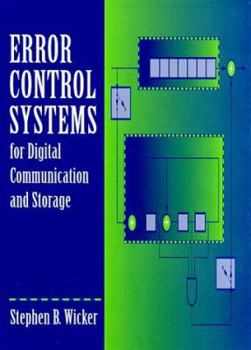Error Control Systems for Digital Communication and Storage
This introductory text on error control coding focuses on key implementation issues and performance analysis with applications valuable to both mathematicians and engineers. It features discussion of... This description may be from another edition of this product.
Format:Paperback
Language:English
ISBN:0132008092
ISBN13:9780132008099
Release Date:January 1994
Publisher:Prentice Hall
Length:624 Pages
Weight:1.80 lbs.
Dimensions:1.0" x 7.3" x 9.6"
Customer Reviews
5 ratings
Error Control Systems for Digital Communication and Storage
Published by Thriftbooks.com User , 17 years ago
This is a well written book on the introduction to error control coding. Although now a little bit outdated (lack of all the new development of the 1990's and 2000's, e.g. Turbo code, LDPC code, etc.), it is a good introductionary book such that students can build up their foundation for futher venture to the error control techniques. It will also facilitate the understanding of the new development. Although, the author complemented the books with another two books for Turbo (1998) and LDPC codes (2002), the writing styles of the two books are not as good as this book. It sounds like the author just wanted to get the two books out to be the first in the area. I really wish that the author can sit down to seriously revise the current book, correct certain mistakes (e.g. p. 109, "message blocks (100), (010), and (001)" should be "message blocks (10), (01)" ), take out the outdated materials, rewrite certain parts, such as magnetic recording channel, maintain his writing style, and add Turbo, LDPC codes, and other new materials to the book. Otherwise, the role of this book will be replaced by new books in this area, and it will be a pity.
A very concise, to-the-point text.....
Published by Thriftbooks.com User , 23 years ago
This is an exhaustive text on practically every known technique used in practical error correction/detection. Every individual technique is outlined in a seperate chapter, with a lot of stress on the practical implementation issues, though it does go heavy on the computational nuances at some places.This book shall require you to have a very solid background on vector/matrix math, and also Galois field arithmetic. Some basic knowledge of Communication System models is also recommended, though not mandatory.The down side of the book is that it does not give exhaustive mathematical proofs of the various algorithms (It was not the original intention of the author in the first place, though it's inclusion would have been really helpful), and secondly, there is no comparative analysis of the various algorithms. In this regard, implementing them in C/C++ could be very instructive to the discerning student.
Good Reference Book
Published by Thriftbooks.com User , 24 years ago
I use this book at work and several co-worker have borrowed the book. Evereyone who has used the book has found it very useful. The book has been used as a reference for implementing error-correcting codes on FPGAs. The examples in the book are excellent and the book could be used as a comprehensive text on error correction. The author starts with the basics and goes into great detail on both block and convolutional codes.
Delivers the Goods
Published by Thriftbooks.com User , 25 years ago
Once you get past the (very necessary) finite field stuff you're hip deep in everything you ever wanted to know about codes - block codes, convolutional codes, binary, ternary, you name it.I found the discussion of Reed-Solomon codes particularly good. So *that's* how they work!Some new stuff missing (Turbo Codes), but that's always going to happen.
nbvmnbv
Published by Thriftbooks.com User , 25 years ago
nbvmn






